The underwater world is rich and diverse. All this wealth is determined by various living conditions. Some of the fish live in the salty waters of the oceans and seas, while others prefer fresh lakes or rivers. Some can survive only in the purest running waters, while others adapted nature to life in muddy, stagnant water. The latter include labyrinth fish. In the process of evolution, they acquired a unique organ that allows them to breathe simple air.
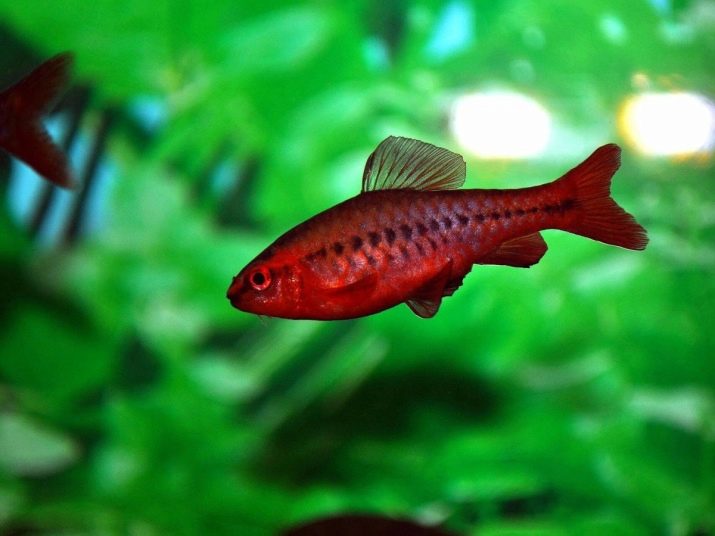
Features
Ray-finned fish from the Creeper order have a special system of plates pierced by blood vessels in the suprabarranial region. This organ is called the "labyrinth" and serves to absorb atmospheric oxygen.
Labyrinth fish, unlike others, need access to atmospheric air, otherwise they may suffocate.
This feature is caused by the fact that In the natural environment, labyrinth fish live in small, densely overgrown, inactive waters of Asia and Africa.
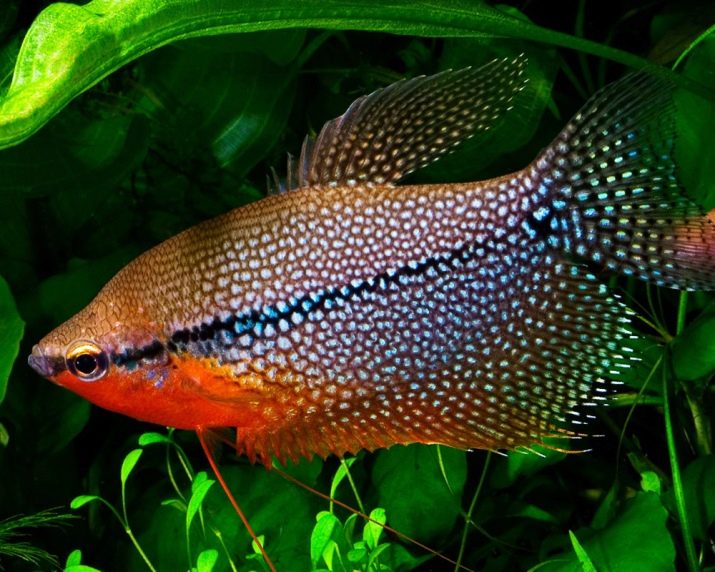
Kinds
The morphological diversity of the Caterpillars is due to habitats. There are three suborders of labyrinth fish:
- Crawler or Anabasov;
- Helostomy;
- Macropod or Guramiaceae.
Crawling
The list of creeping fish includes 33 species, of which only xenopomas are suitable for keeping in the aquarium.
- Ktenopoma leopard. A 15-20 cm long fish native to Central Africa lives in the Congo Basin. A tall, oblate body is covered with yellow-brown scales with large dark spots scattered throughout the body.
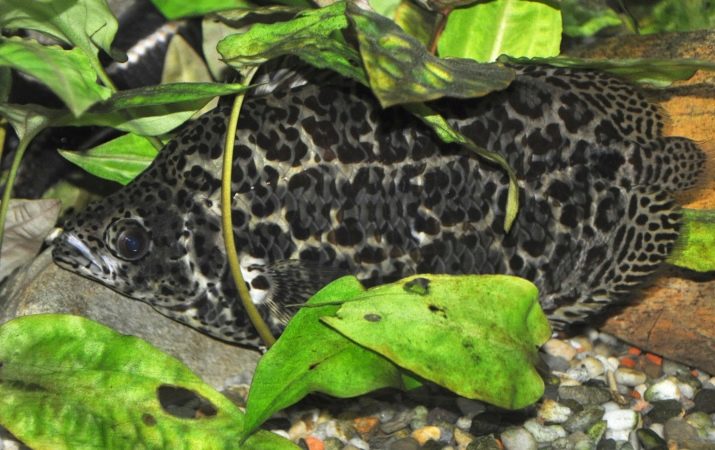
- Ktenopoma Anzorg, unlike leopard, it has a more elongated rounded body up to 7 cm long.Silverfish is decorated with gold-orange uniform transverse stripes, passing on the dorsal and ventral fins. In total there are 6 shingles. Anzorg's character is calm.
She spends most of her time in hiding, floating out to eat.
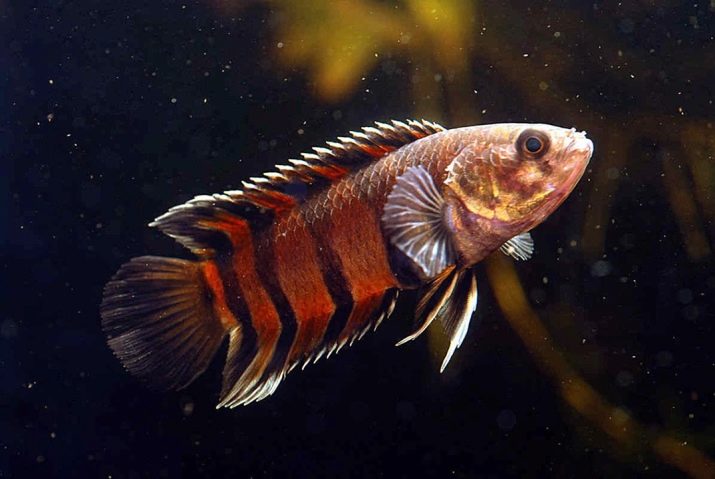
- Ktenopoma eight-way. Flattened laterally, the tall body of an 8-cm dark brown fish is covered with stripes consisting of spots of different colors. The color of the stripes depends on the conditions of detention. Stripes can be brown, lighter shades than the main color, or blue, including transitional colors. An eight-lane ktenopoma is much more aggressive than anzorg in terms of protecting the territory, so you need to carefully approach the selection of the aquarium.

Helostomy
Kissing by gourami is a separate unit of the Crowned - Helostomous. These fish got their name for a special way of eating, fighting and courtship. The elongated mouth of the fish ends with mobile "lips" with many horn teeth on the inside, with the help of which the gourami scrapes algae.
During the fight, the fish catch their lips together and hold each other until one of them yields. Mating games are held in the same manner.
Kissing by gourami - come from Southeast Asia, where they are found quite often, inhabiting small freshwater reservoirs with dense vegetation. Growing in the natural environment up to 30 cm, aquarium fish have a body length of a maximum of 15 cm. Flattened laterally, the relatively high fish contained in the aquarium has only 2 color options - gray and pink.
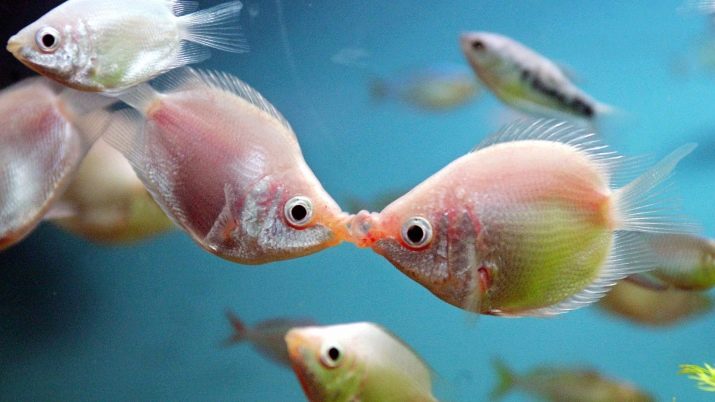
Macropods
Representatives of the family Macropodusinae unite 6 genera. Of these, the most famous Betta or cockerel fish. Bright fish in their natural habitat live in stagnant water bodies and have a nondescript color with a small veil tail. The chic inhabitants of the aquarium are obtained through long-term selection. The character of a small beautiful fish, as the name implies, is fighting. Intraspecific aggression leads to deadly fights, therefore it is better to keep males one by one.
The next genus Macropodus consists of 5 species of macropods.
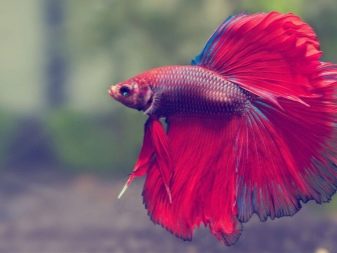
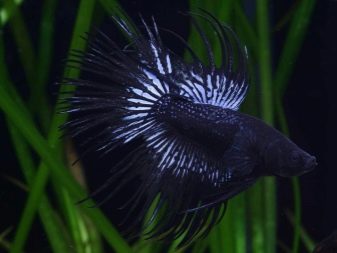
Black, red-backed, and ordinary macropods with greenish scales may have red stripes or be without them.
The length of an adult fish reaches 12 cm. Macropods are so aggressive in nature that they are difficult to keep next to other fish even of their own species.
Kupanus - fish 30-50 mm long with an elongated body. Bright fins are decorated along the edge of a dark stripe. Fish are very demanding on the hardness and acidity of the water, so for beginners it is better not to mess with them. The pH and dGh should be minimal, with the exception of the common cupanus.
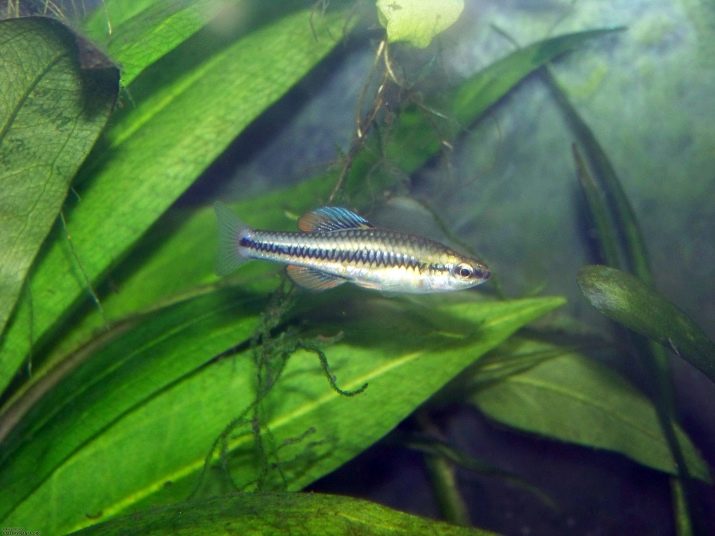
Dwarf Gourami their body shape resembles fighting fish, only they have shorter fins.
The length of an adult does not exceed 40 mm. The fish live in flocks and have a peace-loving character, not suitable for keeping close to aggressive species.
The brown body of the fish is covered with blue medium-sized spots and has a red longitudinal strip from head to tail. On bluish fins there are red spots and a border of the same color. Bright blue eyes have a red rim. Interestingly, during mating games, dwarf gourami are able to make rumbling sounds. Water for such fish requires slightly acidic or neutral.
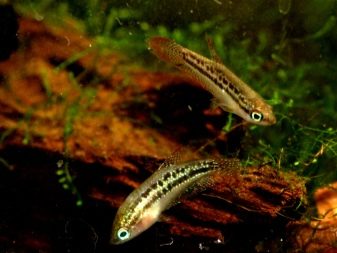

Root-shaped gourami or Parosphromenus include 10 genera, but in aquariums they most often contain 2 species of these small peace-loving fish.
- Dysner's Parosphromenus has a length of 30-45 mm. This is a fish with an elongated, slightly compressed laterally beige body, decorated with three longitudinal stripes. In blue ventral fins, the first ray is elongated. Blue, red and dark brown girdles run along the dorsal, anal fins and a tail similar to an open fan.
For keeping the fish, a small aquarium without aeration and filtration, densely planted with small-leaved greens, is suitable.It is important not to forget to leave the fish free places for swimming and the ability to breathe air.
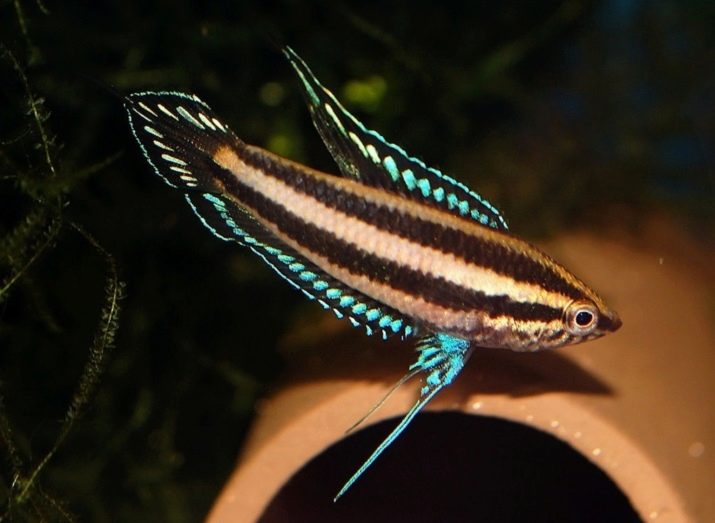
- Acupuncture Parophomenus in appearance and conditions of detention, it does not practically differ from the dysner. Only his body color is brown with a black tint, and two coffee-colored stripes pass along the sides. Dorsal fin extended at end. There is also a golden, dwarf and dark parophomenus, but they are extremely rare. Malpulutta is represented by the only species of Malpulutta Kretser. Extremely shy and very jumping fish up to 70 mm long in the natural environment is on the verge of extinction.
An elongated, slightly flattened laterally small fish is painted in golden brown and covered with small rare spots.
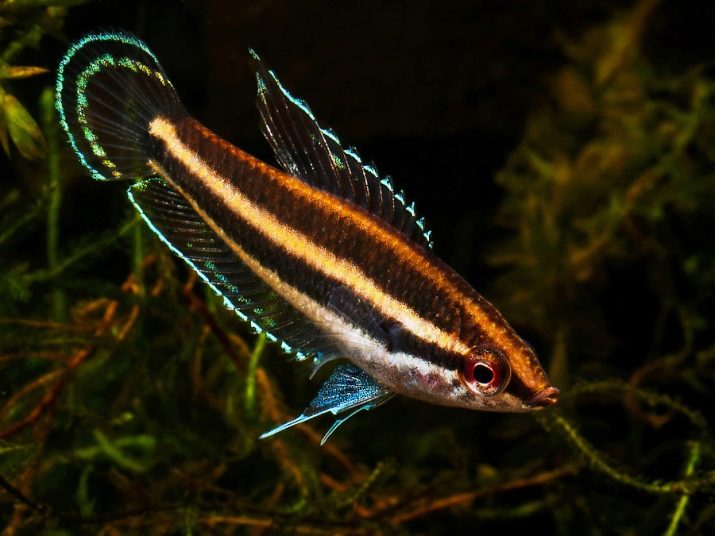
The dorsal and caudal fins are elongated, in the ventral fins the first ray is slightly elongated. She loves to hide in shelters, spending a significant part of her time there. It gets along well with other peaceful fish, smaller in size.
The subfamily Luciocephalinae includes the following genera.
Coliseum
Coliseum or lalius - one of the most popular aquarium fish. They are characterized by filiform abdominal fins. Most often, in aquariums you can find neon, cobalt, rainbow, coral and blue lily. Fish up to 7 cm long are painted in green, yellow or blue with orange spots on the fins.

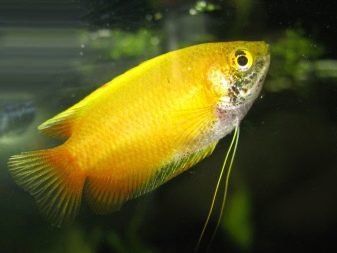
A characteristic feature of laliuses is their ability to shoot water at flying insects.
Honey gourami of red-yellow flowers easily gives offspring, together with lilyuses, therefore, for the purity of the species, you should not keep these two species in one aquarium. The striped coliseum and the similar lyabiosis are red-brown in color with a bright blue longitudinal stripe. Lyabiosis are red with and without stripe.
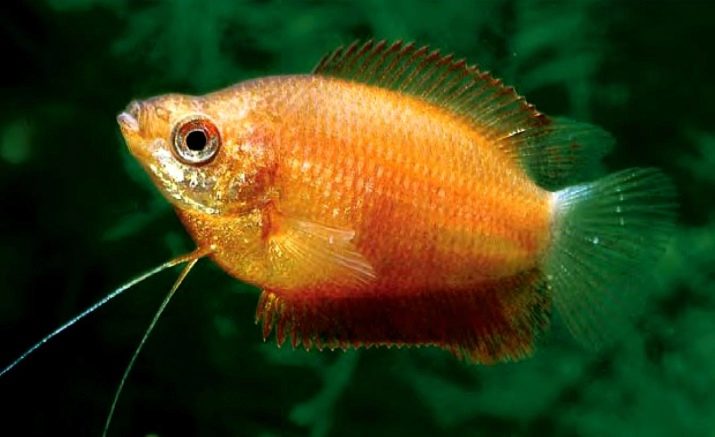
Parasperichty
Paraspherichtus is from Myanmar. There are only 2 types of parasphericht:
- false chocolate gourami - a fish 19 mm long in the color of chocolate with a green tint and light transverse stripes;
- ocular parasphericht - 5 cm long yellow with brown stains.
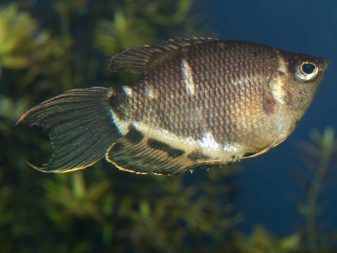
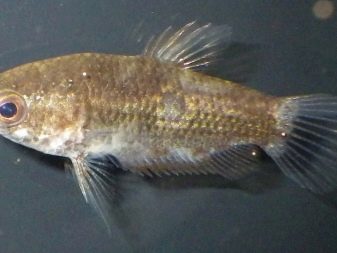
Spherichtes
Beautiful and difficult to maintain chocolate gourami lives in very clean, peaty water, the acidity of which is not higher than 4. But there are also adapted individuals that can live in water with a pH of 6 units.
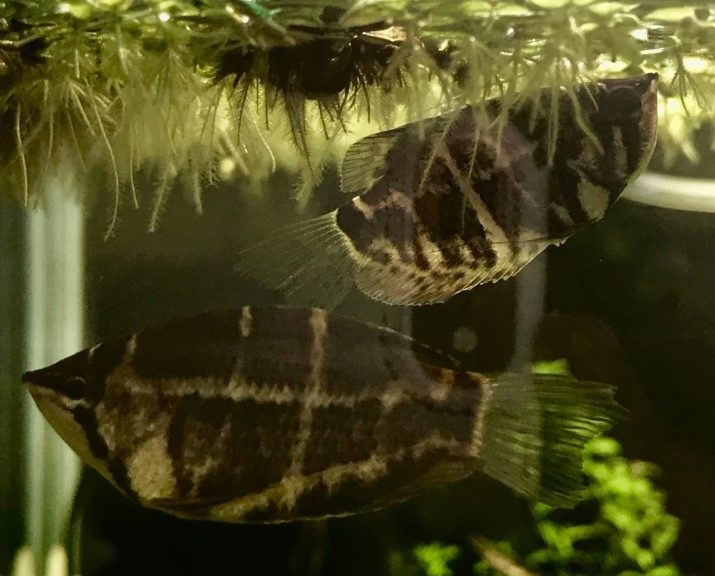
Gourami
One of the most numerous types of aquarium labyrinth fish. Almost all representatives of the gourami have a flattened laterally body up to 15 cm long, decorated with filiform pectoral fins:
- brown or serpentine olive-colored gourami with thin transverse stripes;

- spotted - bluish-gray-olive with a dark spot on each side;
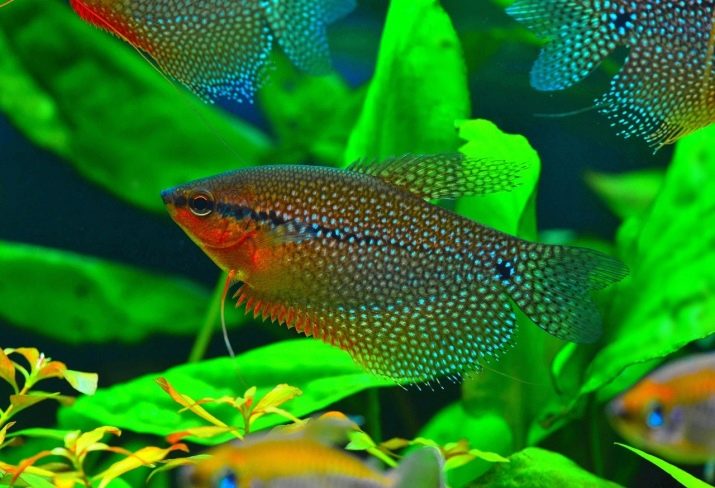
- lunar - silver with a blue tint;
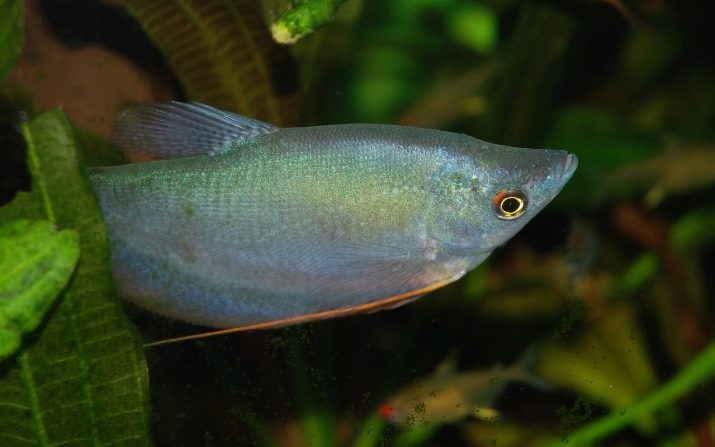
- pearl - the most famous and beautiful representative of the gourami, his lilac body with a silver tint is covered with white spots and a dark, intermittent, longitudinal stripe.

Selection tips
Those who have been engaged in aquariums for a long time will surely cope with any capricious individual, but beginners should pay attention to medium-sized representatives of labyrinth fish that do not require special conditions for keeping:
- cockerels;
- laliuses;
- marble gourami;
- steam phosphromenus.
These types of fish are not so sensitive to the environment and quite get along in a small tank.
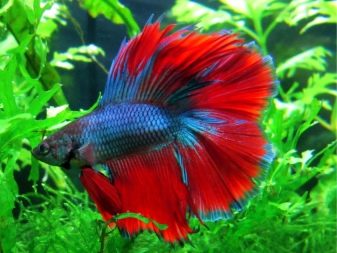
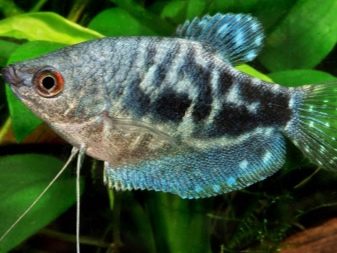
Basic content rules
In the natural environment, labyrinth fish live in inactive, turbid water, poor in oxygen, but rich in organic matter. It would seem that they will be able to live in any environment, but most creepy ones are demanding on water quality. If the amount of dissolved oxygen does not play a large role, then the following factors have a strong influence.
- Rigidity. Her indicator should not exceed 10 units.
- The pH is less than 6.5. Some species require an even more acidic environment.
Almost all types of these fish are prone to jumping, so the aquarium must be covered from above.
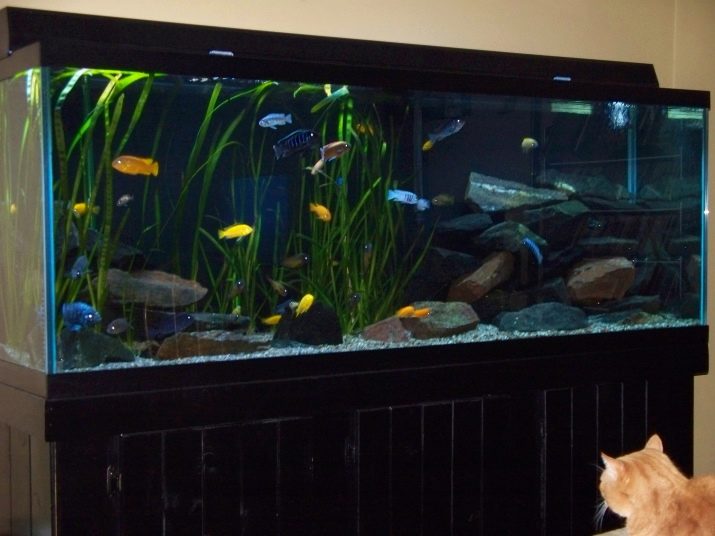
Aquarium Care
The labyrinth house should be filled with living plants, planted in the ground and floating on the surface, with free space for swimming and breathing air.
The soil is used natural, with a diameter of up to 4 mm. Snags, shards, coconut shells and other shelters are laid at the bottom.
Although creeping fish can live in stagnant water, it is better to replace a certain amount of old liquid with fresh one up to 20% once a week. Additional aeration is practically not required, but it is better to use it in large aquariums.
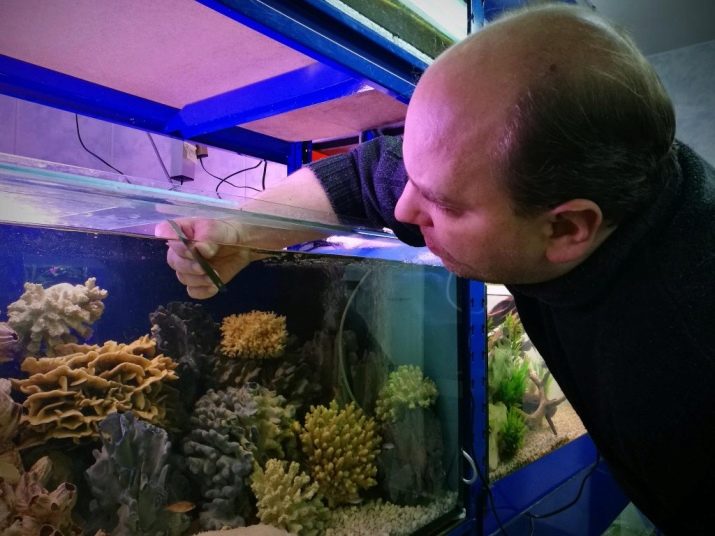
What to feed?
For feeding labyrinth fish, any food is suitable: dry, live and frozen. Fish are fed by spraying food over the surface, as they eat at all levels of the aquarium.
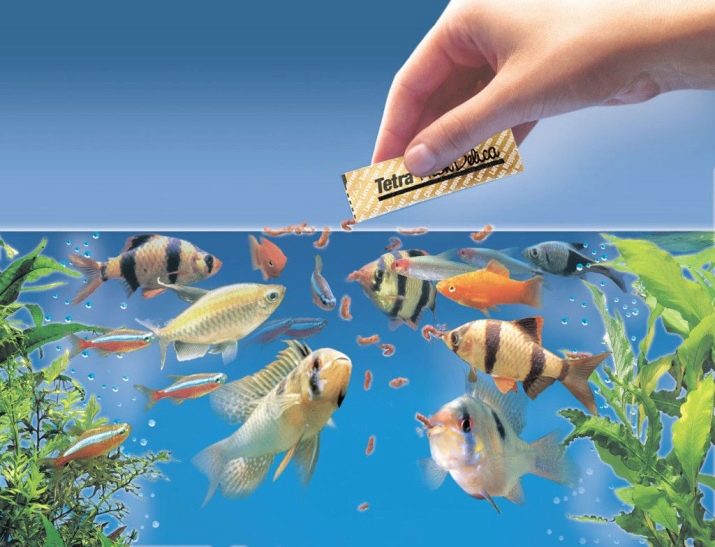
Breeding
The reproduction of labyrinth fish depends on the indicators of water. For the female to lay eggs, very soft and acidified water is needed. Many of the creeping ones build foam nests where they hide the fertilized eggs and hatched larvae.
Nests of each species are special, not like the others.
Some fish use pieces of plants to nest, others simply attach it under the leaf, while others swim freely.
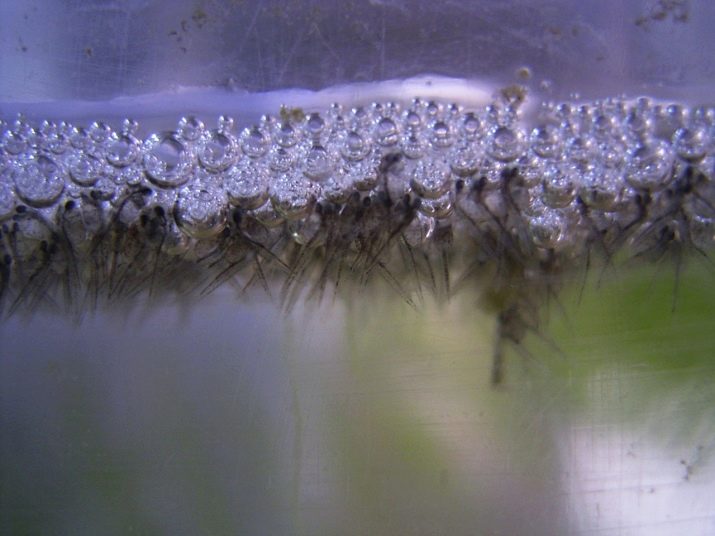
Compatible with other fish
Non-aggressive species of labyrinth fish coexist easily in one aquarium with other peace-loving species, suitable in size:
- swordsmen;
- guppies;
- zebrafish
- Pecilia
- catfish and others similar in nature.
You should not populate the labyrinth along with species that are prone to tearing out veils, such as barbs or cichlids. Large predatory fish also pose a threat to the maze.
About the types of labyrinth fish see below.










